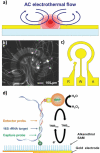In situ electrokinetic enhancement for self-assembled-monolayer-based electrochemical biosensing
- PMID: 22397486
- PMCID: PMC4069200
- DOI: 10.1021/ac203245j
In situ electrokinetic enhancement for self-assembled-monolayer-based electrochemical biosensing
Abstract
This study reports a multifunctional electrode approach which directly implements electrokinetic enhancement on a self-assembled-monolayer-based electrochemical sensor for point-of-care diagnostics. Using urinary tract infections as a model system, we demonstrate that electrokinetic enhancement, which involves in situ stirring and heating, can enhance the sensitivity of the strain specific 16S rRNA hybridization assay for 1 order of magnitude and accelerate the time-limiting incubation step with a 6-fold reduction in the incubation time. Since the same electrode platform is used for both electrochemical signal enhancement and electrochemical sensing, the multifunctional electrode approach provides a highly effective strategy toward fully integrated lab-on-a-chip systems for various biomedical applications.
Figures



References
Publication types
MeSH terms
Substances
Grants and funding
LinkOut - more resources
Full Text Sources
Medical
Miscellaneous

